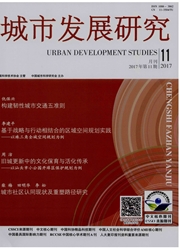

 中文摘要:
中文摘要:
为改善我国城市微气候的基础理论研究相对落后的状况,应对大气污染严重、通风效率低下、热岛效应突出等城市问题,基于系统性规划的视角,指出了以往风环境研究和风道建设实践中,重技术而轻规划,重要素而轻系统,重风道建设而轻风道与风源、通风作用区相衔接等不足;借鉴环境生态控制的"源—流—汇"理念,建构了城市风环境"源—流—汇"系统的绿色控制理论框架,提出城市风环境多层级的构成要素与分类标准,总结了不同空间层级的风道类型与功能构成特点,归纳了风环境系统生态协调原则;根据不同城市结构、城市的不同主导功能区和不同密度与空间形态通风需求,探讨了适应地域气候的生态规划原则,基于"富氧源——扩散流——补偿汇"相互衔接的规划思路,提出了城市风环境效能提升的低碳规划策略和多层级污染源控制及富氧型风源、风道的保护方法。
 英文摘要:
英文摘要:
To improve relatively backward basic theoretical research on urban micro-climate in China and respond to urban problems such as heavy air pollution,low ventilation efficiency and outstanding heat island effects,deficiencies of previous research on wind environment and practices on construction of air ducts that highlighted technologies,elements and construction of air ducts but neglected planning,systems and connections of air ducts with air sources and ventilation phases and so on are pointed out from the perspective of systematic planning. By referring to " source-flow-sink" concepts of environmental and ecological control,a theoretical framework of green control is constructed for " source-flow-sink " system of urban wind environment. Multi-layer components and classification standards of urban wind environment are put forward. Types of air ducts and functional characteristics of different spatial levels are summarized. Besides, ecological coordination principles of wind environment system are summed up. According to ventilation requirements for different urban structures,dominant urban functional zones,density and spatial forms,principles of ecological planning adaptable to regional climate are discussed. Based on the idea of planning integrating " oxygen sources,diffuse flow and compensation sink ",low-carbon planning strategies are proposed for improving efficiency of urban wind environment,while methods are brought forth to control multi-layer sources of pollution and protect oxygen-enriched air sources and air ducts.
 同期刊论文项目
同期刊论文项目
 同项目期刊论文
同项目期刊论文
 期刊信息
期刊信息
